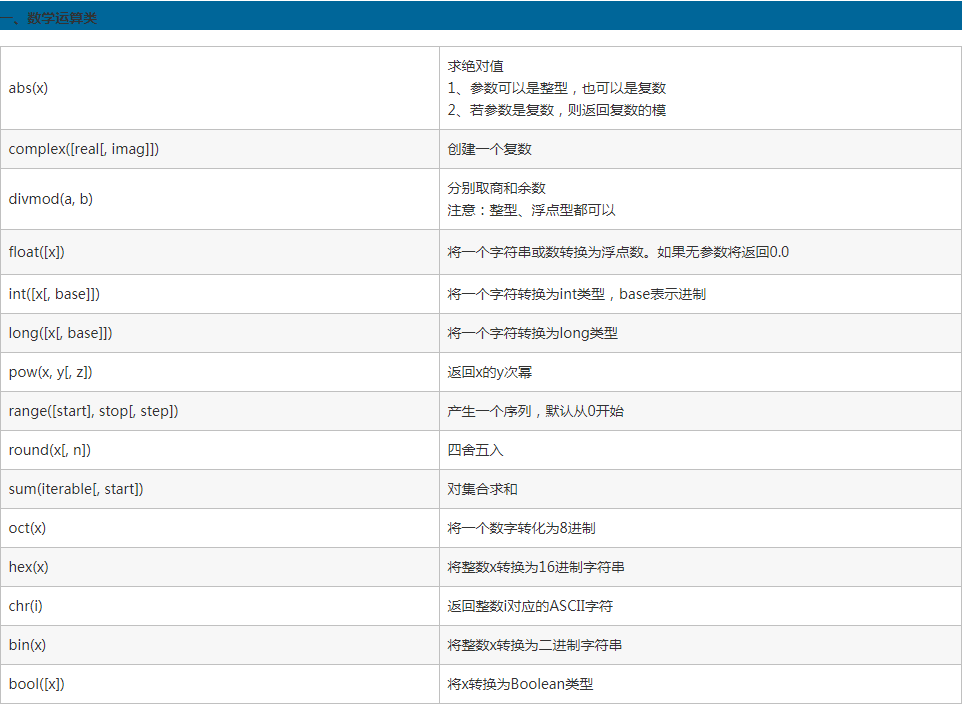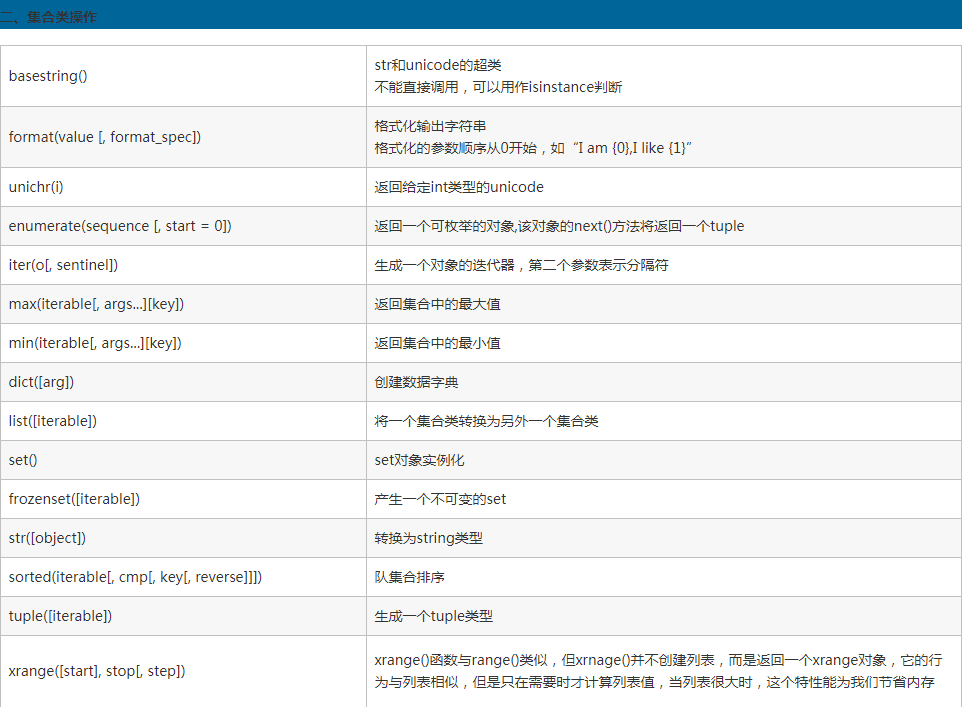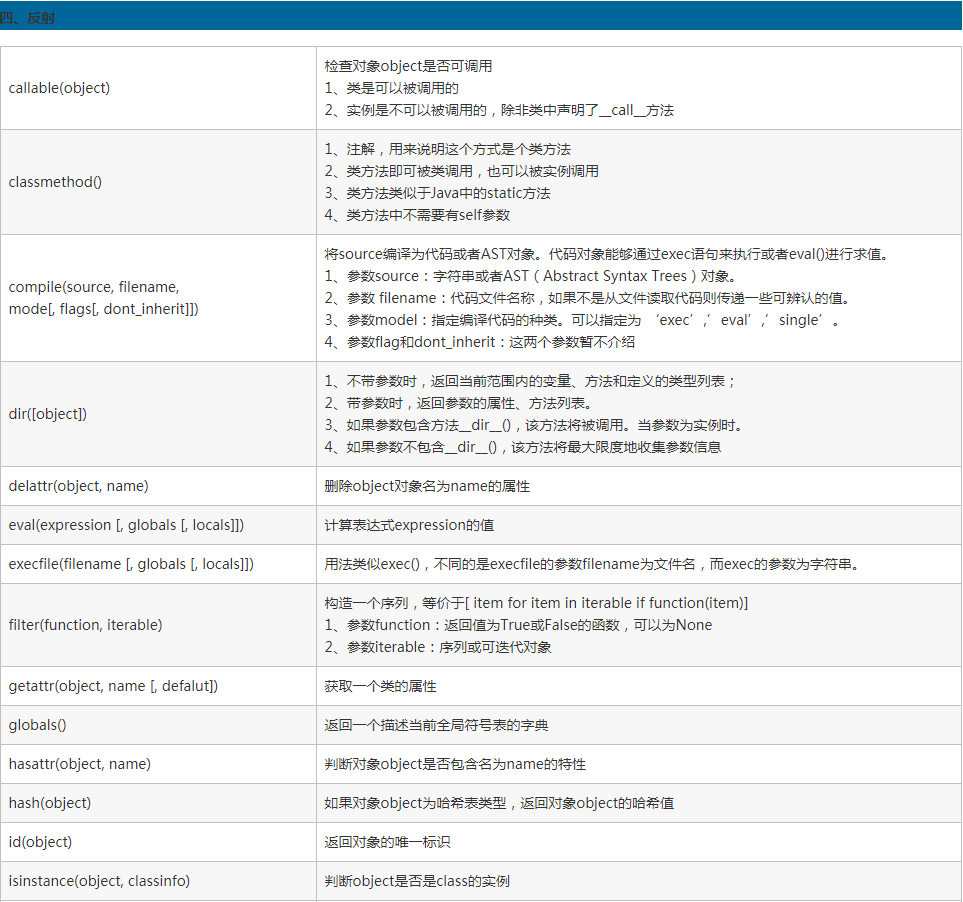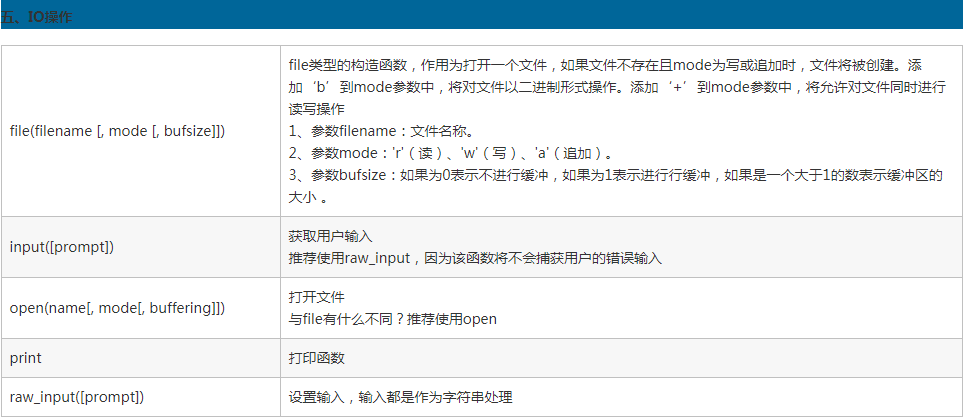您好,登錄后才能下訂單哦!
您好,登錄后才能下訂單哦!
這篇文章主要介紹python中有哪些函數,文中介紹的非常詳細,具有一定的參考價值,感興趣的小伙伴們一定要看完!
Python內置的函數及其用法。為了方便記憶,已經有很多開發者將這些內置函數進行了如下分類:
·數學運算(7個)
·類型轉換(24個)
·序列操作(8個)
·對象操作(7個)
·反射操作(8個)
·變量操作(2個)
·交互操作(2個)
·文件操作(1個)
·編譯執行(4個)
·裝飾器(3個)
python學習網,大量的免費python視頻教程,歡迎在線學習!
接下來看看具體每個類別里包含了那些內置函數:






具體每個函數的解析如下:
數學運算
abs:求數值的絕對值
>>> abs(-2) 2
divmod:返回兩個數值的商和余數
>>> divmod(5,2) (2, 1) >> divmod(5.5,2) (2.0, 1.5)
max:返回可迭代對象中的元素中的最大值或者所有參數的最大值
>>> max(1,2,3) # 傳入3個參數 取3個中較大者
3
>>> max('1234') # 傳入1個可迭代對象,取其最大元素值
'4'
>>> max(-1,0) # 數值默認取數值較大者
0
>>> max(-1,0,key = abs) # 傳入了求絕對值函數,則參數都會進行求絕對值后再取較大者
-1min:返回可迭代對象中的元素中的最小值或者所有參數的最小值
>>> min(1,2,3) # 傳入3個參數 取3個中較小者
1
>>> min('1234') # 傳入1個可迭代對象,取其最小元素值
'1'
>>> min(-1,-2) # 數值默認去數值較小者
-2
>>> min(-1,-2,key = abs) # 傳入了求絕對值函數,則參數都會進行求絕對值后再取較小者
-1pow:返回兩個數值的冪運算值或其與指定整數的模值
>>> pow(2,3) >>> 2**3 >>> pow(2,3,5) >>> pow(2,3)%5
round:對浮點數進行四舍五入求值
>>> round(1.1314926,1) 1.1 >>> round(1.1314926,5) 1.13149
sum:對元素類型是數值的可迭代對象中的每個元素求和
# 傳入可迭代對象 >>> sum((1,2,3,4)) 10 # 元素類型必須是數值型 >>> sum((1.5,2.5,3.5,4.5)) 12.0 >>> sum((1,2,3,4),-10) 0
類型轉換
bool:根據傳入的參數的邏輯值創建一個新的布爾值
>>> bool() #未傳入參數 False >>> bool(0) #數值0、空序列等值為False False >>> bool(1) True
int:根據傳入的參數創建一個新的整數
>>> int() #不傳入參數時,得到結果0。 0 >>> int(3) 3 >>> int(3.6) 3
float:根據傳入的參數創建一個新的浮點數
>>> float() #不提供參數的時候,返回0.0
0.0
>>> float(3)
3.0
>>> float('3')
3.0complex:根據傳入參數創建一個新的復數
>>> complex() #當兩個參數都不提供時,返回復數 0j。
0j
>>> complex('1+2j') #傳入字符串創建復數
(1+2j)
>>> complex(1,2) #傳入數值創建復數
(1+2j)str:返回一個對象的字符串表現形式(給用戶)
>>> str()
''
>>> str(None)
'None'
>>> str('abc')
'abc'
>>> str(123)
'123'bytearray:根據傳入的參數創建一個新的字節數組
>>> bytearray('中文','utf-8')
bytearray(b'\xe4\xb8\xad\xe6\x96\x87')bytes:根據傳入的參數創建一個新的不可變字節數組
>>> bytes('中文','utf-8')
b'\xe4\xb8\xad\xe6\x96\x87'memoryview:根據傳入的參數創建一個新的內存查看對象
>>> v = memoryview(b'abcefg') >>> v[1] 98 >>> v[-1] 103
ord:返回Unicode字符對應的整數
>>> ord('a')
97chr:返回整數所對應的Unicode字符
>>> chr(97) #參數類型為整數 'a'
bin:將整數轉換成2進制字符串
>>> bin(3) '0b11'
oct:將整數轉化成8進制數字符串
>>> oct(10) '0o12'
hex:將整數轉換成16進制字符串
>>> hex(15) '0xf'
tuple:根據傳入的參數創建一個新的元組
>>> tuple() #不傳入參數,創建空元組
()
>>> tuple('121') #傳入可迭代對象。使用其元素創建新的元組
('1', '2', '1')list:根據傳入的參數創建一個新的列表
>>>list() # 不傳入參數,創建空列表
[]
>>> list('abcd') # 傳入可迭代對象,使用其元素創建新的列表
['a', 'b', 'c', 'd']dict:根據傳入的參數創建一個新的字典
>>> dict() # 不傳入任何參數時,返回空字典。
{}
>>> dict(a = 1,b = 2) # 可以傳入鍵值對創建字典。
{'b': 2, 'a': 1}
>>> dict(zip(['a','b'],[1,2])) # 可以傳入映射函數創建字典。
{'b': 2, 'a': 1}
>>> dict((('a',1),('b',2))) # 可以傳入可迭代對象創建字典。
{'b': 2, 'a': 1}set:根據傳入的參數創建一個新的集合
>>>set() # 不傳入參數,創建空集合
set()
>>> a = set(range(10)) # 傳入可迭代對象,創建集合
>>> a
{0, 1, 2, 3, 4, 5, 6, 7, 8, 9}frozenset:根據傳入的參數創建一個新的不可變集合
>>> a = frozenset(range(10))
>>> a
frozenset({0, 1, 2, 3, 4, 5, 6, 7, 8, 9})enumerate:根據可迭代對象創建枚舉對象
>>> seasons = ['Spring', 'Summer', 'Fall', 'Winter'] >>> list(enumerate(seasons)) [(0, 'Spring'), (1, 'Summer'), (2, 'Fall'), (3, 'Winter')] >>> list(enumerate(seasons, start=1)) #指定起始值 [(1, 'Spring'), (2, 'Summer'), (3, 'Fall'), (4, 'Winter')]
range:根據傳入的參數創建一個新的range對象
>>> a = range(10) >>> b = range(1,10) >>> c = range(1,10,3) >>> a,b,c # 分別輸出a,b,c (range(0, 10), range(1, 10), range(1, 10, 3)) >>> list(a),list(b),list(c) # 分別輸出a,b,c的元素 ([0, 1, 2, 3, 4, 5, 6, 7, 8, 9], [1, 2, 3, 4, 5, 6, 7, 8, 9], [1, 4, 7]) >>>
iter:根據傳入的參數創建一個新的可迭代對象
>>> a = iter('abcd') #字符串序列
>>> a
<str_iterator object at 0x03FB4FB0>
>>> next(a)
'a'
>>> next(a)
'b'
>>> next(a)
'c'
>>> next(a)
'd'
>>> next(a)
Traceback (most recent call last):
File "<pyshell#29>", line 1, in <module>
next(a)
StopIterationslice:根據傳入的參數創建一個新的切片對象
>>> c1 = slice(5) # 定義c1 >>> c1 slice(None, 5, None) >>> c2 = slice(2,5) # 定義c2 >>> c2 slice(2, 5, None) >>> c3 = slice(1,10,3) # 定義c3 >>> c3 slice(1, 10, 3)
super:根據傳入的參數創建一個新的子類和父類關系的代理對象
#定義父類A
>>> class A(object):
def __init__(self):
print('A.__init__')
#定義子類B,繼承A
>>> class B(A):
def __init__(self):
print('B.__init__')
super().__init__()
#super調用父類方法
>>> b = B()
B.__init__
A.__init__object:創建一個新的object對象
>>> a = object() >>> a.name = 'kim' # 不能設置屬性 Traceback (most recent call last): File "<pyshell#9>", line 1, in <module> a.name = 'kim' AttributeError: 'object' object has no attribute 'name'
序列操作
all:判斷可迭代對象的每個元素是否都為True值
>>> all([1,2]) #列表中每個元素邏輯值均為True,返回True
True
>>> all([0,1,2]) #列表中0的邏輯值為False,返回False
False
>>> all(()) #空元組
True
>>> all({}) #空字典
Trueany:判斷可迭代對象的元素是否有為True值的元素
>>> any([0,1,2]) #列表元素有一個為True,則返回True
True
>>> any([0,0]) #列表元素全部為False,則返回False
False
>>> any([]) #空列表
False
>>> any({}) #空字典
Falsefilter:使用指定方法過濾可迭代對象的元素
>>> a = list(range(1,10)) #定義序列 >>> a [1, 2, 3, 4, 5, 6, 7, 8, 9] >>> def if_odd(x): #定義奇數判斷函數 return x%2==1 >>> list(filter(if_odd,a)) #篩選序列中的奇數 [1, 3, 5, 7, 9]
map:使用指定方法去作用傳入的每個可迭代對象的元素,生成新的可迭代對象
>>> a = map(ord,'abcd') >>> a <map object at 0x03994E50> >>> list(a) [97, 98, 99, 100]
next:返回可迭代對象中的下一個元素值
>>> a = iter('abcd')
>>> next(a)
'a'
>>> next(a)
'b'
>>> next(a)
'c'
>>> next(a)
'd'
>>> next(a)
Traceback (most recent call last):
File "<pyshell#18>", line 1, in <module>
next(a)
StopIteration
#傳入default參數后,如果可迭代對象還有元素沒有返回,則依次返回其元素值,如果所有元素已經返回,則返回default指定的默認
值而不拋出StopIteration 異常
>>> next(a,'e')
'e'
>>> next(a,'e')
'e'reversed:反轉序列生成新的可迭代對象
>>> a = reversed(range(10)) # 傳入range對象 >>> a # 類型變成迭代器 <range_iterator object at 0x035634E8> >>> list(a) [9, 8, 7, 6, 5, 4, 3, 2, 1, 0]
sorted:對可迭代對象進行排序,返回一個新的列表
>>> a = ['a','b','d','c','B','A'] >>> a ['a', 'b', 'd', 'c', 'B', 'A'] >>> sorted(a) # 默認按字符ascii碼排序 ['A', 'B', 'a', 'b', 'c', 'd'] >>> sorted(a,key = str.lower) # 轉換成小寫后再排序,'a'和'A'值一樣,'b'和'B'值一樣 ['a', 'A', 'b', 'B', 'c', 'd']
zip:聚合傳入的每個迭代器中相同位置的元素,返回一個新的元組類型迭代器
>>> x = [1,2,3] #長度3 >>> y = [4,5,6,7,8] #長度5 >>> list(zip(x,y)) # 取最小長度3 [(1, 4), (2, 5), (3, 6)]
對象操作
help:返回對象的幫助信息
>>> help(str) Help on class str in module builtins: class str(object) | str(object='') -> str | str(bytes_or_buffer[, encoding[, errors]]) -> str | | Create a new string object from the given object. If encoding or | errors is specified, then the object must expose a data buffer | that will be decoded using the given encoding and error handler. | Otherwise, returns the result of object.__str__() (if defined) | or repr(object). | encoding defaults to sys.getdefaultencoding(). | errors defaults to 'strict'. | | Methods defined here: | | __add__(self, value, /) | Return self+value. | ***************************
dir:返回對象或者當前作用域內的屬性列表
>>> import math >>> math <module 'math' (built-in)> >>> dir(math) ['__doc__', '__loader__', '__name__', '__package__', '__spec__', 'acos', 'acosh', 'asin', 'asinh', 'atan', 'atan2', 'atanh', 'ceil', 'copysign', 'cos', 'cosh', 'degrees', 'e', 'erf', 'erfc', 'exp', 'expm1', 'fabs', 'factorial', 'floor', 'fmod', 'frexp', 'fsum', 'gamma', 'gcd', 'hypot', 'inf', 'isclose', 'isfinite', 'isinf', 'isnan', 'ldexp', 'lgamma', 'log', 'log10', 'log1p', 'log2', 'modf', 'nan', 'pi', 'pow', 'radians', 'sin', 'sinh', 'sqrt', 'tan', 'tanh', 'trunc']
id:返回對象的唯一標識符
>>> a = 'some text' >>> id(a) 69228568
hash:獲取對象的哈希值
>>> hash('good good study')
1032709256type:返回對象的類型,或者根據傳入的參數創建一個新的類型
>>> type(1) # 返回對象的類型
<class 'int'>
#使用type函數創建類型D,含有屬性InfoD
>>> D = type('D',(A,B),dict(InfoD='some thing defined in D'))
>>> d = D()
>>> d.InfoD
'some thing defined in D'len:返回對象的長度
>>> len('abcd') # 字符串
>>> len(bytes('abcd','utf-8')) # 字節數組
>>> len((1,2,3,4)) # 元組
>>> len([1,2,3,4]) # 列表
>>> len(range(1,5)) # range對象
>>> len({'a':1,'b':2,'c':3,'d':4}) # 字典
>>> len({'a','b','c','d'}) # 集合
>>> len(frozenset('abcd')) #不可變集合ascii:返回對象的可打印表字符串表現方式
>>> ascii(1)
'1'
>>> ascii('&')
"'&'"
>>> ascii(9000000)
'9000000'
>>> ascii('中文') #非ascii字符
"'\\u4e2d\\u6587'"format:格式化顯示值
#字符串可以提供的參數 's' None
>>> format('some string','s')
'some string'
>>> format('some string')
'some string'
#整形數值可以提供的參數有 'b' 'c' 'd' 'o' 'x' 'X' 'n' None
>>> format(3,'b') #轉換成二進制
'11'
>>> format(97,'c') #轉換unicode成字符
'a'
>>> format(11,'d') #轉換成10進制
'11'
>>> format(11,'o') #轉換成8進制
'13'
>>> format(11,'x') #轉換成16進制 小寫字母表示
'b'
>>> format(11,'X') #轉換成16進制 大寫字母表示
'B'
>>> format(11,'n') #和d一樣
'11'
>>> format(11) #默認和d一樣
'11'
#浮點數可以提供的參數有 'e' 'E' 'f' 'F' 'g' 'G' 'n' '%' None
>>> format(314159267,'e') #科學計數法,默認保留6位小數
'3.141593e+08'
>>> format(314159267,'0.2e') #科學計數法,指定保留2位小數
'3.14e+08'
>>> format(314159267,'0.2E') #科學計數法,指定保留2位小數,采用大寫E表示
'3.14E+08'
>>> format(314159267,'f') #小數點計數法,默認保留6位小數
'314159267.000000'
>>> format(3.14159267000,'f') #小數點計數法,默認保留6位小數
'3.141593'
>>> format(3.14159267000,'0.8f') #小數點計數法,指定保留8位小數
'3.14159267'
>>> format(3.14159267000,'0.10f') #小數點計數法,指定保留10位小數
'3.1415926700'
>>> format(3.14e+1000000,'F') #小數點計數法,無窮大轉換成大小字母
'INF'
#g的格式化比較特殊,假設p為格式中指定的保留小數位數,先嘗試采用科學計數法格式化,得到冪指數exp,如果-4<=exp<p,則采用
小數計數法,并保留p-1-exp位小數,否則按小數計數法計數,并按p-1保留小數位數
>>> format(0.00003141566,'.1g') #p=1,exp=-5 ==》 -4<=exp<p不成立,按科學計數法計數,保留0位小數點
'3e-05'
>>> format(0.00003141566,'.2g') #p=1,exp=-5 ==》 -4<=exp<p不成立,按科學計數法計數,保留1位小數點
'3.1e-05'
>>> format(0.00003141566,'.3g') #p=1,exp=-5 ==》 -4<=exp<p不成立,按科學計數法計數,保留2位小數點
'3.14e-05'
>>> format(0.00003141566,'.3G') #p=1,exp=-5 ==》 -4<=exp<p不成立,按科學計數法計數,保留0位小數點,E使用大寫
'3.14E-05'
>>> format(3.1415926777,'.1g') #p=1,exp=0 ==》 -4<=exp<p成立,按小數計數法計數,保留0位小數點
'3'
>>> format(3.1415926777,'.2g') #p=1,exp=0 ==》 -4<=exp<p成立,按小數計數法計數,保留1位小數點
'3.1'
>>> format(3.1415926777,'.3g') #p=1,exp=0 ==》 -4<=exp<p成立,按小數計數法計數,保留2位小數點
'3.14'
>>> format(0.00003141566,'.1n') #和g相同
'3e-05'
>>> format(0.00003141566,'.3n') #和g相同
'3.14e-05'
>>> format(0.00003141566) #和g相同
'3.141566e-05'vars:返回當前作用域內的局部變量和其值組成的字典,或者返回對象的屬性列表
#作用于類實例
>>> class A(object):
pass
>>> a.__dict__
{}
>>> vars(a)
{}
>>> a.name = 'Kim'
>>> a.__dict__
{'name': 'Kim'}
>>> vars(a)
{'name': 'Kim'}反射操作
__import__:動態導入模塊
index = __import__('index')
index.sayHello()isinstance:判斷對象是否是類或者類型元組中任意類元素的實例
>>> isinstance(1,int) True >>> isinstance(1,str) False >>> isinstance(1,(int,str)) True
issubclass:判斷類是否是另外一個類或者類型元組中任意類元素的子類
>>> issubclass(bool,int) True >>> issubclass(bool,str) False >>> issubclass(bool,(str,int)) True
hasattr:檢查對象是否含有屬性
#定義類A
>>> class Student:
def __init__(self,name):
self.name = name
>>> s = Student('Aim')
>>> hasattr(s,'name') #a含有name屬性
True
>>> hasattr(s,'age') #a不含有age屬性
Falsegetattr:獲取對象的屬性值
#定義類Student >>> class Student: def __init__(self,name): self.name = name >>> getattr(s,'name') #存在屬性name 'Aim' >>> getattr(s,'age',6) #不存在屬性age,但提供了默認值,返回默認值 >>> getattr(s,'age') #不存在屬性age,未提供默認值,調用報錯 Traceback (most recent call last): File "<pyshell#17>", line 1, in <module> getattr(s,'age') AttributeError: 'Stduent' object has no attribute 'age'
setattr:設置對象的屬性值
>>> class Student:
def __init__(self,name):
self.name = name
>>> a = Student('Kim')
>>> a.name
'Kim'
>>> setattr(a,'name','Bob')
>>> a.name
'Bob'delattr:刪除對象的屬性
#定義類A
>>> class A:
def __init__(self,name):
self.name = name
def sayHello(self):
print('hello',self.name)
#測試屬性和方法
>>> a.name
'小麥'
>>> a.sayHello()
hello 小麥
#刪除屬性
>>> delattr(a,'name')
>>> a.name
Traceback (most recent call last):
File "<pyshell#47>", line 1, in <module>
a.name
AttributeError: 'A' object has no attribute 'name'callable:檢測對象是否可被調用
>>> class B: #定義類B
def __call__(self):
print('instances are callable now.')
>>> callable(B) #類B是可調用對象
True
>>> b = B() #調用類B
>>> callable(b) #實例b是可調用對象
True
>>> b() #調用實例b成功
instances are callable now.變量操作
globals:返回當前作用域內的全局變量和其值組成的字典
>>> globals()
{'__spec__': None, '__package__': None, '__builtins__': <module 'builtins' (built-in)>, '__name__': '__main__',
'__doc__': None, '__loader__': <class '_frozen_importlib.BuiltinImporter'>}
>>> a = 1
>>> globals() #多了一個a
{'__spec__': None, '__package__': None, '__builtins__': <module 'builtins' (built-in)>, 'a': 1, '__name__':
'__main__', '__doc__': None, '__loader__': <class '_frozen_importlib.BuiltinImporter'>}locals:返回當前作用域內的局部變量和其值組成的字典
>>> def f():
print('before define a ')
print(locals()) #作用域內無變量
a = 1
print('after define a')
print(locals()) #作用域內有一個a變量,值為1
>>> f
<function f at 0x03D40588>
>>> f()
before define a
{}
after define a
{'a': 1}交互操作
print:向標準輸出對象打印輸出
>>> print(1,2,3) 1 2 3 >>> print(1,2,3,sep = '+') 1+2+3 >>> print(1,2,3,sep = '+',end = '=?') 1+2+3=?
input:讀取用戶輸入值
>>> s = input('please input your name:')
please input your name:Ain
>>> s
'Ain'文件操作
open:使用指定的模式和編碼打開文件,返回文件讀寫對象
# t為文本讀寫,b為二進制讀寫
>>> a = open('test.txt','rt')
>>> a.read()
'some text'
>>> a.close()編譯執行
compile:將字符串編譯為代碼或者AST對象,使之能夠通過exec語句來執行或者eval進行求值
>>> #流程語句使用exec >>> code1 = 'for i in range(0,10): print (i)' >>> compile1 = compile(code1,'','exec') >>> exec (compile1) 0 1 2 3 4 5 6 7 8 9 >>> #簡單求值表達式用eval >>> code2 = '1 + 2 + 3 + 4' >>> compile2 = compile(code2,'','eval') >>> eval(compile2) 10
eval:執行動態表達式求值
>>> eval('1+2+3+4')
10exec:執行動態語句塊
>>> exec('a=1+2') #執行語句
>>> a
3repr:返回一個對象的字符串表現形式(給解釋器)
>>> a = 'some text' >>> str(a) 'some text' >>> repr(a) "'some text'"
裝飾器
property:標示屬性的裝飾器
>>> class C:
def __init__(self):
self._name = ''
@property
def name(self):
"""i'm the 'name' property."""
return self._name
@name.setter
def name(self,value):
if value is None:
raise RuntimeError('name can not be None')
else:
self._name = value
>>> c = C()
>>> c.name # 訪問屬性
''
>>> c.name = None # 設置屬性時進行驗證
Traceback (most recent call last):
File "<pyshell#84>", line 1, in <module>
c.name = None
File "<pyshell#81>", line 11, in name
raise RuntimeError('name can not be None')
RuntimeError: name can not be None
>>> c.name = 'Kim' # 設置屬性
>>> c.name # 訪問屬性
'Kim'
>>> del c.name # 刪除屬性,不提供deleter則不能刪除
Traceback (most recent call last):
File "<pyshell#87>", line 1, in <module>
del c.name
AttributeError: can't delete attribute
>>> c.name
'Kim'classmethod:標示方法為類方法的裝飾器
>>> class C:
@classmethod
def f(cls,arg1):
print(cls)
print(arg1)
>>> C.f('類對象調用類方法')
<class '__main__.C'>
類對象調用類方法
>>> c = C()
>>> c.f('類實例對象調用類方法')
<class '__main__.C'>
類實例對象調用類方法staticmethod:標示方法為靜態方法的裝飾器
# 使用裝飾器定義靜態方法
>>> class Student(object):
def __init__(self,name):
self.name = name
@staticmethod
def sayHello(lang):
print(lang)
if lang == 'en':
print('Welcome!')
else:
print('你好!')
>>> Student.sayHello('en') #類調用,'en'傳給了lang參數
en
Welcome!
>>> b = Student('Kim')
>>> b.sayHello('zh') #類實例對象調用,'zh'傳給了lang參數
zh
你好以上是python中有哪些函數的所有內容,感謝各位的閱讀!希望分享的內容對大家有幫助,更多相關知識,歡迎關注億速云行業資訊頻道!
免責聲明:本站發布的內容(圖片、視頻和文字)以原創、轉載和分享為主,文章觀點不代表本網站立場,如果涉及侵權請聯系站長郵箱:is@yisu.com進行舉報,并提供相關證據,一經查實,將立刻刪除涉嫌侵權內容。